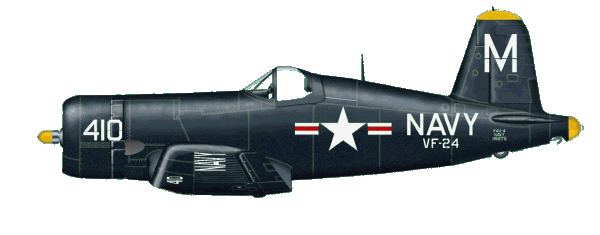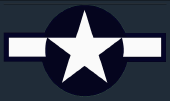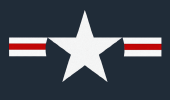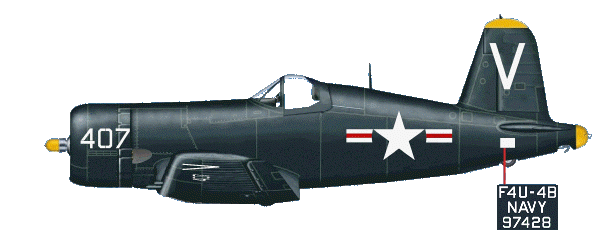|
|
|
SB2C-5 of VA-9A 1948 on CV-47 "Philippine
Sea". The usual deck paint ("deck stain") heavily weathered. |
| U.S. Navy
National Museum of Naval Aviation photo No. 1996.253.254 [1] |
| |
|
|
| F4U-4B of
VF-114, Air Group 11, mid 1950 on CV-47 Philippine Sea. Foto: US Navy |
| According to
4th Squadron (400 numbers) color marking in orange-yellow. |
| |
|
|
|
Glossy Sea Blue also for folding areas of
the wings, landing gear, wells and wheels. Photo Wilfried Eck |
| |
|
|
|
F9F-2B Panther of VF-112 1950 on CV-47
"Philippine Sea" |
| The light-colored leading
edges of wings, tanks, and stabilizers are not bare metal, but
unofficially (test-applied) abrasion-resistant paint ("Rain Erosion
Resistant Paint"). - Photo: US National Museum of Naval Aviation. |
| |
|
|
| FH-1 Phantom
of VMF 122, US Marine Corps (recognizable by the underlined "BC") in "Sea
Blue" color. |
|
U.S Navy National Museum of Naval Aviation,
photo No.01996.253.7239.030.jpg |
| |
|
|
|
|
|
|
Illustration to the right column |
|
F4U-4 of VF-24, Air Group 2 (registration
"M"); coming from CV-45 "Valley Forge", replacing Air Group 11 on the
"Philippine Sea" as of mid-1951 |
 |
 |
 |
|
wings upper sides |
wings lower sides |
|
| |
|
|
| |
|
|
|
Colors
according to directive SR-15e of 10.10.1944 according to Federal
Standard No. 595a/ANA |
|
(repeated
with SR-2F of 02.01.1947 and MIL-F-7179 of 16.04.1951): |
|
Airframe: |
Glossy Sea Blue |
FS 15042, ANA 623 |
| |
|
|
|
Landing gear: |
Glossy Sea Blue |
FS 15042, ANA 623 |
| |
|
|
|
Landing gear wells and flaps: |
Glossy Sea Blue |
FS 15042, ANA 623 |
| |
|
|
|
Cockpit above lower edge
of instrument panel: |
Non Specular Black |
FS 37038, ANA 604 |
|
Cockpit below lower edge
of instrument panel: |
Interior Green |
FS 34151, ANA 611 |
| |
|
|
|
National insignia*: |
(Glossy) Insignia Blue* |
FS 15044, ANA 605 |
| |
(Glossy) Insignia White |
FS 17875, ANA 601 |
| |
|
|
|
Engine hood inside (since
06.03.1944): |
Non Specular Black |
FS 37038, ANA 604 |
|
Engine hood interior
according to Amendment 3 to SR-2F, 01.05.1949: |
NS Interior Green* |
FS 34151, ANA 611 |
| |
|
|
|
Airscrew Blades: |
Black |
FS 17038, ANA 515 |
|
Airscrew tips: |
Orange Yellow |
FS 13538, ANA 506 |
| |
|
|
| |
|
|
|
* |
Insignia Blue is not
blue at all. Due to the high proportion of black, it is darker
than Sea Blue, almost black. With rare fading, it becomes dark
gray. |
|
|
|
|
|
|
|
|
|
Effective
June 10, 1946, Amendment 1 to Army-Navy Specification AN-I-9b: |
|
 |
|
In the
national insignia, the disk and side bar surrounds in Insignia Blue
can be omitted (only the star and bars in Insignia White).
Previously, this had only been allowed for Grumman. |
|
| |
|
Effective January 14, 1947, Amendment 2 to Army-Navy Specification
AN-I-9b: |
|
 |
|
In
the national insignia, a stripe in Insignia Red, FS 11136, is
inserted in the horizontal bar (length equal to radius of the
star, width 1/2 radius). Width 1/6 radius. As a result, three
stripes of equal width to the left and right of the star. |
|
 |
|
|
|
| |
|
May 01
1948, SR-2F Amendment Three: |
|
Marking colors for
squadrons (upper seven inches of vertical stabilizer and airscrew
hubs): |
|
|
| 1.
Squadron: |
Insignia Red, FS
11136, ANA 509 |
4.
Squadron: |
Light Yellow, FS
14187, ANA 503 |
| 2.
Squadron: |
Insignia White, FS
17875, ANA 511 |
5.
Squadron: |
Light Green, FS
14187, ANA |
| 3.
Squadron: |
Light Blue, FS 15102,
ANA 501 |
6.
Squadron: |
Black
17038, ANA 515, Rand Ins. White |
|
| |
|
May 12 1950, SR-2G Amendment I: |
|
Aircraft of the reserve
receive a vertical band in "Orange Yellow", FS 13538, ANA 614 around
the disk of the national insignia . Below centered indication of the
base in half font size. |
| |
|
"Rain
Resistant Paint": |
|
What appeared to be bare
leading edges on the wings and empennage, especially on F9F-2
Panther and FJ-2, -3 Fury, was actually a special aluminum-based
paint. Probably for test purposes, because there was no official
regulation until 1955. |
| |
|
03 Aug. 1953, SR-202 "Exterior
Color Requirements for Naval Aircraft" |
|
Jet air intakes: color of
exterior drawn around 2 1/2 inches, 6.35 cm, into (white) intake
opening |
| |
|
25 May
1954, BuAer NAVAER 07.01 for all aircraft: |
|
Cockpit now Dark Gull Gray,
FS 36231. In black: frame interiors that can cause glare, control knobs,
instrument bezels and information signs. Later, the black was
increasingly dispensed with for frames; the decisive factor here is the
individual case.. |
|
|
|
Since subsequent
directives only dealt with the exterior and at most regulated the
color of the control knobs, cockpit color is surprisingly still "Dark
Gull Gray" at present. |
| |
|
| |
| Markings: |
| |
Although the basic
principles still in force today were laid down at the end of 1946,
they were subject to reforms in detail that would far exceed the
scope of this article.
What remained unchanged, however, was the "block style" lettering,
i.e. letters and numerals consisting of straight bars of
standardized width and height with 45° beveled corners (30° as of
March 5, 1982). |
| |
|
07 Nov. 1946,
Circular
Letter No 156-46: |
|
Unit identifing letter/s ("Tail Code") for the Essex-class carriers,
remaining light carriers (CVL) and escort carriers (CVE) used for
sub-hunting. |
| |
|
12/12/1946,
Aviation Circular Letter No 156-46, for shipboard stationed aircraft: |
| |
 |
 |
 |
|
wing uppersides |
wing lower siedes |
|
|
|
- In departure from
Circular Letter No 156-46, letters on the vertical stabilizer of fleet
carrier (CV, CVA) based aircraft identify the parent Air Group.
|
- Carrier based Marine
Corps airplanes retain their double letters (first letter Marine
Aircraft Wing, No. 1 "A," MAW 2 "B," MAW 3 "W"; 2nd letter Squadron
within MAW). To avoid confusion, however, underlined until 1949.
|
- Only Fighter and Attack
Squadrons, designation VF- or VA- plus number. Other mission
designations, such as "T-" for torpedo squadron, "B-" bomber, are
omitted.
|
- Individual numbering on
the bow, three-digit numbers as follows:
|
| |
| 1. VF-
(Fighter-) Squadron:
101 - 199 |
1. VA- (Attack) Squadron:
401 - 499 |
| 2. VF-
(Fighter-) Squadron: 201 -
299 |
2. VA- (Attack) Squadron:
501 - 599 |
| 3. VF-
(Fighter-) Squadron: 301 -
399 |
Other
Squadron: 600 ff. |
| Commander Air
Group: x00 |
Commander
Air Group: x00 |
|
|
| |
|
02 Jan. 1947, Aviation
Circular Letter SR 2F: |
| |
- Identification letter(s)
on the vertical stabilizer 36 inches (91.44 cm) high, stroke width 4
inches (10.16 cm), with double letters 30 inches (76.2 cm) high, line
width reduced accordingly.
|
- Aircraft type, NAVY or
MARINES and serial number each centered below each other below leading
edge of tailplane, letter size 1 inch (2.54 cm).
|
- Letter(s) of "Tail
Code" now also on top of right wing and bottom of left wing, centered
6 inches (15.24 cm) from wing tip; number to left of this 18 inches
(45.72 cm) apart.
|
|
|
| |
|
28 Feb. 1947, Amendment I to SR-2F: |
|
The distance between the national insignia and the identification
letters is 1/3 of the length of the wing from the wing tip. |
| |
|
12 May 1950, SR-2G
Amendment I for all aircraft (mandatory only June 16, 1952): |
| |
- "NAVY" or "MARINES" on
fuselage forward of tailplane, size 12, 16, 20, 24, 28 inches. Other
locations permitted if required by type. Below, centered at half
height of lettering, the designation of the squadron or home base. The
national insignia moves forward to a suitable location.
|
- "NAVY" or "MARINES" on
underside of left wing, as far out as possible, letter height 24 or 30
inches (60.96 cm/76.20 cm). Orientation horizontal, to be read from
front left to right. The individual number moves to the inside.
|
- Identification letter(s)
and individual number under the left wing are separated. The
identification letter at height 16 inches (40.64 cm) now to the right
of the national insignia, moved inward, the individual number to the
left of NAVY or MARINES, also moved inward accordingly.
|
|
|
| |
|
15 Sep.1954,
MIL-I-6140(ASG): |
| |
|
On aircraft with swept wings, the sovereignty insignia is aligned with
the (imaginary) centerline of the wing depth. Similarly, the inscription
on the other side. |
| |
| |
| |
|
|